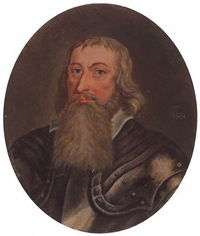Ulick Burke, 1st Marquess of Clanricarde

Ulick MacRichard Burke, 5th Earl of Clanricarde, 2nd Earl of St Albans, 1st Marquess of Clanricarde (1604, London – July 1657, Kent), was an Irish nobleman who was involved in the Wars of the Three Kingdoms. Clanricarde was a Catholic Royalist, who had overall command of the Irish forces during the later stages of the Cromwellian conquest of Ireland.
Background
He was the son of Richard Burke, 4th Earl of Clanricarde, by his wife Frances Walsingham.[1] Ulick's father was from an Anglo-Norman family who had been long settled in the west of Ireland and become Gaelicised. Although during the early Sixteenth century the family had rebelled against the Crown on several occasions, Ulick's father had been a strong supporter of Elizabeth I. He fought on the Queen's side during Tyrone's Rebellion, notably during the victory at Battle of Kinsale where he was wounded. After the war he married the widow of Earl of Essex, a recent commander in Ireland, who was the daughter of the English Secretary of State and spymaster Francis Walsingham.
In 1622, Ulick married his only wife Anne Compton, the daughter of William Compton, 1st Earl of Northampton and his wife Elizabeth Spencer. They had a single child, Margaret Burgh who married Charles MacCarty, Viscount Muskerry.
Ulick was summoned to the House of Lords as Lord Burgh in 1628, and succeeded his father as 5th Earl in 1635. In 1636, he inherited Somerhill House on the death of his father.[2] He was a staunch opponent of the policies of the Lord Deputy of Ireland, Thomas Wentworth, 1st Earl of Strafford, who had attempted to seize much of the great Burke inheritance for the Crown; there was also personal ill-feeling since the dispute was thought by many to have hastened the death of Ulick's elderly father. He sat in the Short Parliament of 1640 and attended Charles I in the Scottish expedition. Charles, unlike Strafford, liked and trusted Ulick.
Wars of the Three Kingdoms
Somerhill was sequestered by Parliament in 1645, following the Battle of Naseby.[2] During the Irish Confederate Wars, Burke supported the Royalist leader Ormonde in defending Ireland for Charles I against the Parliamentarians by uniting Catholic and Protestant nobles (he being Catholic). He did not join the Catholic Confederate Ireland, but instead helped to broker a military alliance between the Confederates and English Royalists. He commanded the forces of this alliance during the Cromwellian conquest of Ireland, after Ormonde fled the country, and soldiers of his Connaught army helped to win a minor (if insubstantial) victory at the battle of Tecroghan. Only a few months later however his army was wiped out during the battle of Meelick Island. Burke was a skillful diplomat but not a great soldier. Like Ormonde, Clanricarde was distrusted by most Catholics in Ireland (he was widely considered to be a friend of the notorious Charles Coote) and thus was thus not capable of halting the Parliamentarian conquest of the country. He was also widely regarded as a man whose actions were governed almost entirely by self-interest.
Later life
In 1652, he made peace with the victorious Oliver Cromwell. He lost his lands in the Act of Settlement 1652 but his heirs regained them after the Restoration of Charles II in the Act of Settlement 1662. On his death the marquessate became extinct; the earldom passed to his cousin Richard.
References
- ↑
 Chisholm, Hugh, ed. (1911). "Clanricarde, Ulick de Burgh, Marquess of". Encyclopædia Britannica. 6 (11th ed.). Cambridge University Press. pp. 421–422.
Chisholm, Hugh, ed. (1911). "Clanricarde, Ulick de Burgh, Marquess of". Encyclopædia Britannica. 6 (11th ed.). Cambridge University Press. pp. 421–422. - 1 2 Colbran, John (1840). Colbran's New Guide for Tunbridge Wells. Cornhill, London: A H Bailey & Co. pp. 332–33. (p 332, p 333)
 "Burgh, Ulick de". Dictionary of National Biography. London: Smith, Elder & Co. 1885–1900.
"Burgh, Ulick de". Dictionary of National Biography. London: Smith, Elder & Co. 1885–1900.
Bibliography
- Ó Siochrú, Michael. God's Executioner: Oliver Cromwell and the Conquest of Ireland. Faber & Faber, 2009.
| Peerage of Ireland | ||
|---|---|---|
| Preceded by New creation |
Marquess of Clanricarde 1646–1657 |
Succeeded by Extinct |
| Preceded by Richard Burke |
Earl of Clanricarde 1635–1657 |
Succeeded by Richard Burke |
| Peerage of England | ||
| Preceded by Richard Burke |
Earl of St. Albans 1635–1657 |
Succeeded by Extinct |